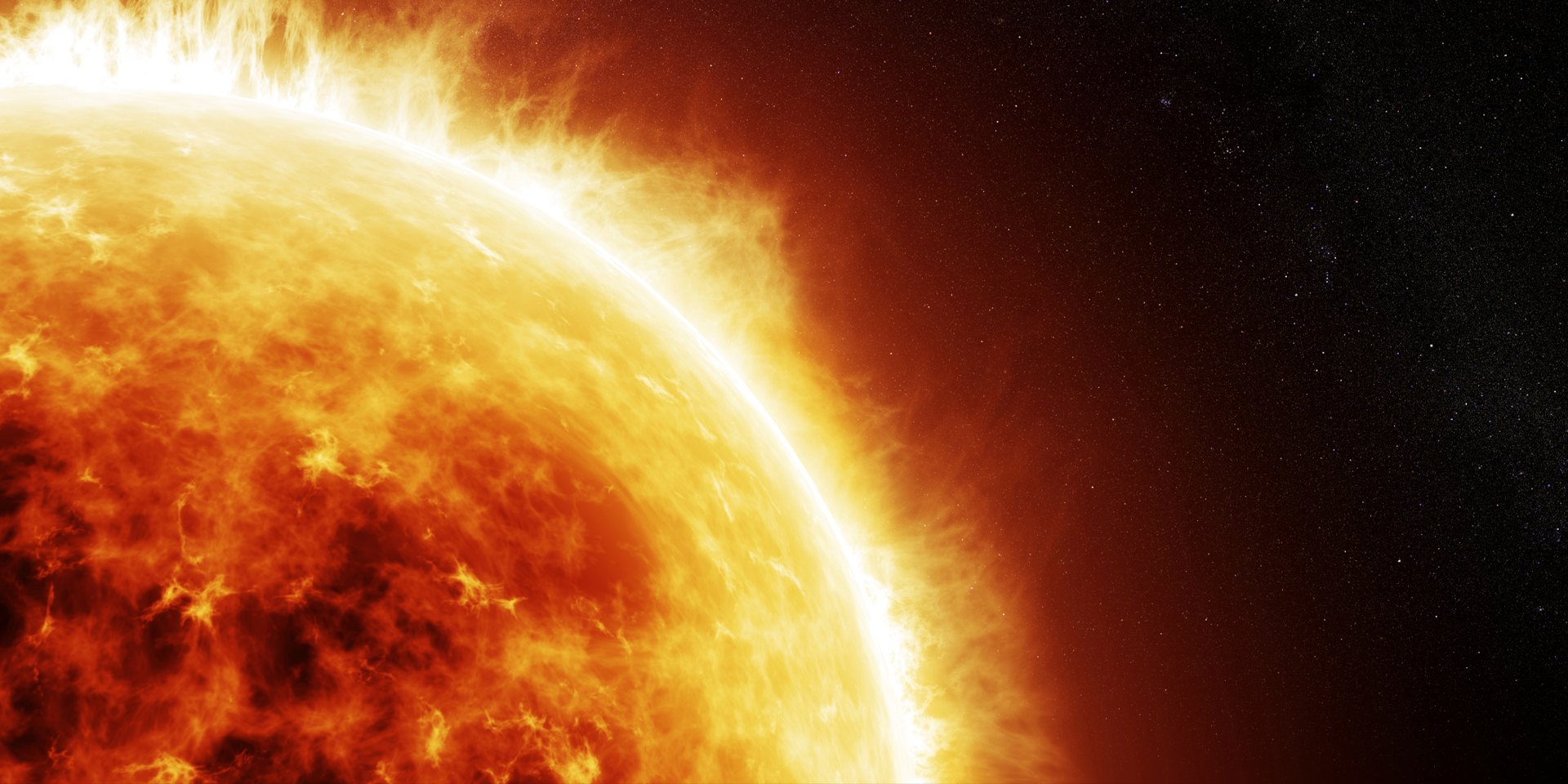
OLN.I | The Sun
Our Sun – that warm, happy thing in the sky that makes flowers grow and gives you a tan in the summertime – is actually a horrifying monster.
Our Sun, the centre of our Solar System, is really a roiling ball of plasma 109 times larger than Earth, and has a surface temperature of 5500 degrees Celsius. You already know you’d never actually get all the way there because you’d vaporize well in advance of landing, but did you know, that even if you solved the heat problem, the massive amounts of radiation that our Sun gives off would kill all life approaching it anyway? (The Sun’s radiation even reaches all the way back to Earth and beyond. In fact, if we didn’t have a magnetic field protecting us, we’d all be toast here, too!)

The Sun accounts for 99.86% of the mass in the solar system. It has a mass of around 330,000 times that of Earth. It is three quarters hydrogen and most of its remaining mass is helium.The energy created by the Sun’s core is the result of nuclear fusion. This huge amount of energy is produced when four hydrogen nuclei are combined into one helium nucleus.
Sometimes sunspots form on the surface of the Sun, appearing to be dark blemishes or even holes in the surface. These form due to strong magnetic field lines coming up from within the Sun that pass through the solar surface and appear visibly as dark spots compared to their surroundings. These sunspots, which can become many times bigger than the Earth itself, are dark because they are much cooler than the surrounding surface of the Sun itself. The Sun will also produce solar flares, which are explosive bursts of radiation, seen as bright areas on the sun. They can last from minutes to hours, and although the heat of a solar flare can’t make it all the way to Earth, the electromagnetic radiation definitely can. Solar flares can alter our upper atmosphere, which can interfere with transmissions from satellites. This can disrupt communications, which can even result in inaccurate GPS information (so the next time you rely on Google maps and end up somewhere strange, remember even Google can’t control the Sun!)
Most of what we’ve learned about the sun has come from a distance. In 2018, that changed. The Parker Solar Probe was launched with the goal of improving our understanding of the Sun’s outer layer, called the corona, and also the nature of solar wind. This probe will get closer to the sun than any previous spacecraft: within 3.8 million miles of the surface. That may not sound close, but it’s more than seven times closer than the previous record.
What is solar wind, anyway? The sun’s corona gets as hot as 2 million degrees Fahrenheit, and gravity isn’t enough to hold onto these particles, so they go streaming out into space. Solar winds cause the beautiful aurora borealis displays, but they can also damage our satellites or even throw off Global Positioning Systems. As we send spacecraft further into space, it’s crucial that we understand what they will encounter out there, so learning as much as possible about how solar winds work and even when they might occur can mean the difference between the success or failure of a mission.
 We all know to never ever look directly at the sun, but even if you could, it’s not like you’d be able to make out much detail. But in January of 2020, a telescope in Hawaii gave us a new view of the surface of the sun. And it looks like . . . popcorn? The Daniel K. Inouye Solar Telescope captured features as small as 19 miles across, the highest resolution images of the solar surface ever taken. Bright areas show where the hotter gas is rising from the surface; the darker borders are where it’s cooling and sinking.
We all know to never ever look directly at the sun, but even if you could, it’s not like you’d be able to make out much detail. But in January of 2020, a telescope in Hawaii gave us a new view of the surface of the sun. And it looks like . . . popcorn? The Daniel K. Inouye Solar Telescope captured features as small as 19 miles across, the highest resolution images of the solar surface ever taken. Bright areas show where the hotter gas is rising from the surface; the darker borders are where it’s cooling and sinking.
Though the Sun is the only star in our solar system, it is one of trillions of stars throughout the universe. There are many different types of stars that we know of: neutron stars, black dwarfs, white dwarfs, brown dwarfs, red dwarfs, yellow dwarfs, blue giants, red giants, blue super giants and red super giants are just a few. Our sun is a yellow dwarf. A yellow dwarf stars has an approximate lifespan of 10 billion years before it becomes a red giant, and eventually a white dwarf before it burns out altogether. But since our sun is only about halfway through its lifespan, we have about 5 billion years before that happens. We’ll talk more about stars, different kinds of stars, and the life cycle of a star, in a future unit.
Now that we’ve gone through the part of the solar system that’s closest to the sun, let’s move out a little further. Next up: the suburbs. What’s the galactic equivalent of a Dad with a barbecue?
Curriculum Reference Links
- Earth and Space / Building Blocks/ 1: Students should be able to describe the relationships between various celestial objects including moons, asteroids, comets, planets, stars, solar systems, galaxies and space.
- Earth and Space / Building Blocks/ 3: Students should be able to interpret data to compare the Earth with other planets and moons in the solar system, with respect to properties including mass, gravity, size, and composition.




